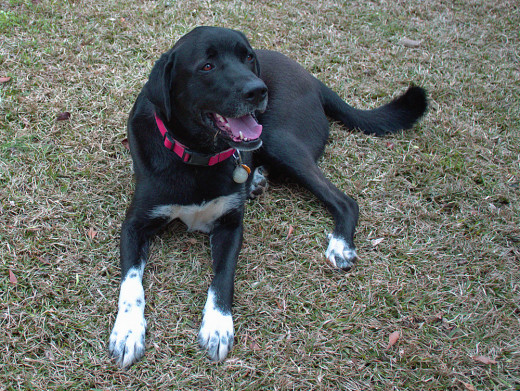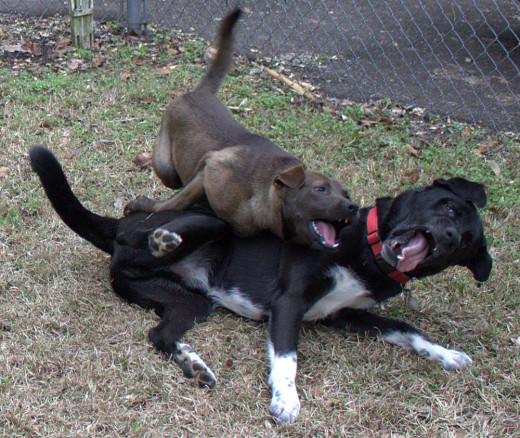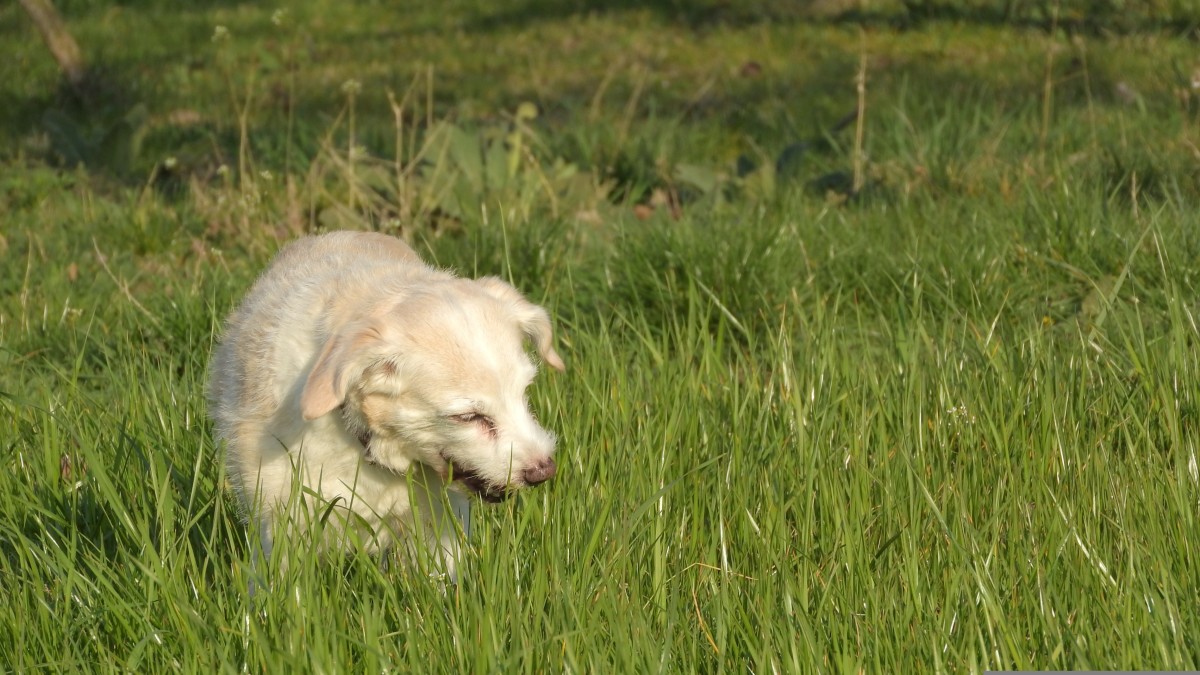How to Play Safely in the Dog Park
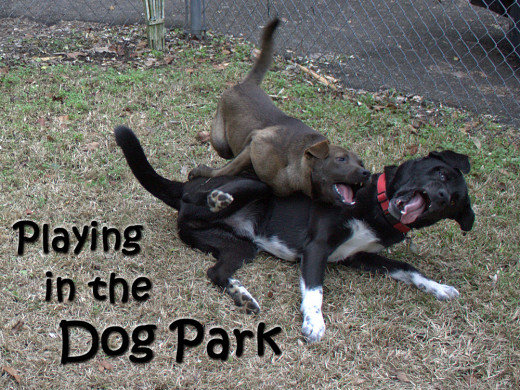
Welcome to the Dog Park!
An enclosed, off-leash dog park is a great place for dogs to run full speed, or amble about at their own pace, sniffing and peeing on things. They can meet other dogs and people, and play as hard as they like. With no worry about running into traffic, you can both relax and enjoy a pleasant day with friends.
On the other hand, dog parks are full of strange dogs. It's kind of like a preschool playdate, if all the toddlers had claws and long, sharp teeth. But if you plan ahead and learn how to manage properly, you can give your best friend a great outing!
Balanced Play
Your goal when dogs play together is excitement that doesn't escalate into aggression. Both dogs should be joining in freely, and shouldn't feel it necessary to make threats to defend themselves. If one tries to hide or shows discomfort by lunging or flashing teeth, the other should back off or engage more gently. If it's not going well or one gets irritated, call the dogs away and get them moving out into the open. Learn to recognize when your dog is getting tired and take him home before he feels it necessary to show teeth.
In the video above, we have a nice example of well-balanced play. My Badger, aged two and a half, is wrestling with Atlas, a six-month-old on his first visit to the park. The game resembles a slow-motion fight. They're pulling their punches, opening their mouths wide and putting them on each other but not biting down.
Notice how Atlas is a bit intimidated and retreats under the bench several times. Badger, instead of pushing him further, goes down on his back, and Atlas comes out voluntarily. This is the hallmark of good play - the dogs maintain an even balance and neither tries to escape. There's a rhythm to it. Harder-playing dogs will have a faster rhythm, but you'll learn to recognize when both parties are happy.
Planning Ahead
On your first visit to a dog park, you'll be nervous. You may not know how your dog will react to strangers. Your first impulse may be to linger outside the fence, or keep your dog on-leash inside the park. But dogs who are restrained by leashes or fences feel vulnerable and anxious about loose dogs, and may try to drive them away.
So plan ahead to introduce your dog to the park. Scout it out without your dog and ask other folks what times the park is empty or little used. Then bring your dog in to explore the area by himself. He'll get a chance to relax and feel confident before he meets strangers.
While you're checking the park, see if there's a fountain or hose. If not you can bring a bowl and jug of water. Dogs get thirsty real quick when running.
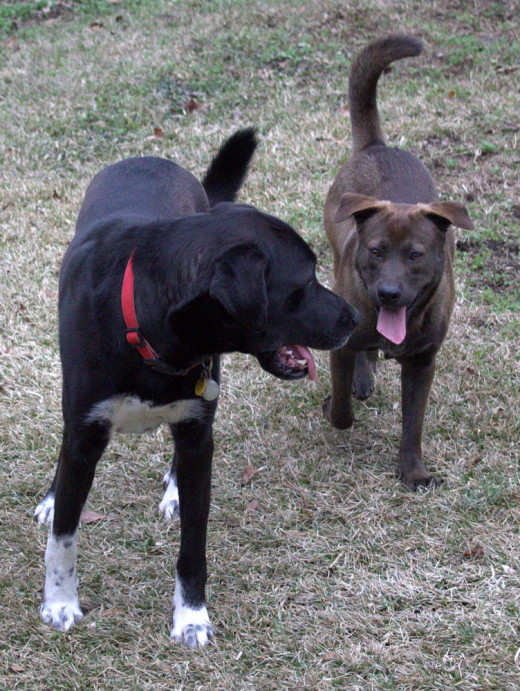
Away From the Gate
You'll see it again and again: the humans linger near the gate on the closest bench, and the dogs stay with them. Then as each newcomer approaches, the group piles up on the gate and makes it difficult to enter. Once the new guy is in, everybody shoves up to him and pushes him into a corner, where he panics and starts a scuffle.
Not only that, but the constant wear near the gate means everybody is sitting in either a cloud of dust or a mud puddle. So move your dog down the park and give everyone a little space!
And if your dog's a greeter, please lead him away when new dogs arrive. He'll meet the newbies soon enough, and they'll be a lot more relaxed away from the gate.
The Collar Grab
There may be times in the dog park when you'l need to control your dog and lead him away; when the play gets too intense, for instance, or if he's bullying another dog or carrying on at the fence. Or maybe it's just time to leash up and go home! The trouble is, many dogs' reaction to having their collar grabbed is to either skitter away, or twist around and grab your wrist.
Train the collar grab before you go to the park. Gently take hold of your dog's collar, and with the other hand move a treat over his nose towards his eyes until he sits. Then give him the treat and let him go. Practice this for several days. Then when you go to dog parks, randomly take his collar and tell him to sit, then immediately release him to play. This teaches him that having his collar grabbed is routine and nothing to be nervous about.
Small or Large Side?
Dog parks often have a section for small dogs, usually those under 25 or 30 pounds. If you have small dogs please use it. Go with a friend if you have different-sized dogs, so somebody can sit with the little ones. Yes, you may be lonely watching all the fun on the big dog side, but please please please don't bring that little fluffy over to be trampled.
Or worse than trampled. My Badger (the gentle giant in the videos) was once being harassed by a pushy little fluffy. He's usually very tolerant of small dogs, but something about that guy pushed him over the edge. In an instant, he seized the little beast by the throat and pinned him to the ground. Mr. Pushy wan't hurt a bit and not particularly intimidated, but a touchier dog might have killed him just as fast. And when dogs are killed in a park, it's usually a small one being attacked by a larger one. Keep them safe!
Ball-Chasing Dogs
Many hunting and working dogs are intense, focused players who prefer chasing balls or discs to wrestling. Sometimes they have limited social skills and may ignore or frighten other dogs. You'll want to play fetch and other games with them at the park.
To avoid bending over a million times to pick up a slobbery tennis ball, use a "ball launcher" or "ball chucker" to scoop it off the ground and sling it a good distance. Great exercise for you both!
Just be aware that the ball-chasing dogs, as I call them, can get possessive of their toys. It's the biggest cause of dog park scuffles and fights - an intense chaser gets interrupted by another dog and defends his slobbery property. If your guy is that type, try to play with him away from the others, and move him on if they come too close.

Get Off the Bench
In the picture above, we see an established group of dogs and people, who have known each other a long time are comfortable. The dogs play while the humans gossip, and there's rarely a problem. But see Jack, with the red harness? One day I looked up and saw my great big Badger dangling Jack from that harness like a suitcase. Moral: Watch the dogs!
If the other dogs aren't well-known to you, then stay off the bench. It doesn't matter if the other owners are lounging, you walk around, pet the dogs, and stay near your own. Be ready to call your guy to move on if things get intense. Observe how he plays with the strangers and intervene when necessary.
Park Activities
Some parks have activities for the dogs: agility or obstacle courses, bridges, or climbing structures. These are great for when nobody else shows up, or on days when your dog feels anti-social, bored, or too excited. Train him on the quiet days and you'll be able to keep him focused and occupied on busier ones. (I won't tell if you bring some treats in for rewards when you're all alone!)
To the right is a brief video clip of my Badger learning to go over jumps. The park also has a tunnel and hoops, so there's a variety of skills to practice.
On the Bad Days
Not every visit is going to be a good time at the park. I try to go when there'll be a few dogs, but not a crowd. Badger doesn't like mob scenes and I don't think it's safe.
Pay attention to your instincts. If your dog is being pushed around and seems unhappy, go take a walk and try again another day, with different (or fewer) dogs. If some misguided person brings their toddler in where your big dog is tearing around like a steam engine, it's time to go someplace else.
Every day won't be a good day, but most of them can be! Enjoy your dog park visit!


© 2014 Valerie Proctor Davis




